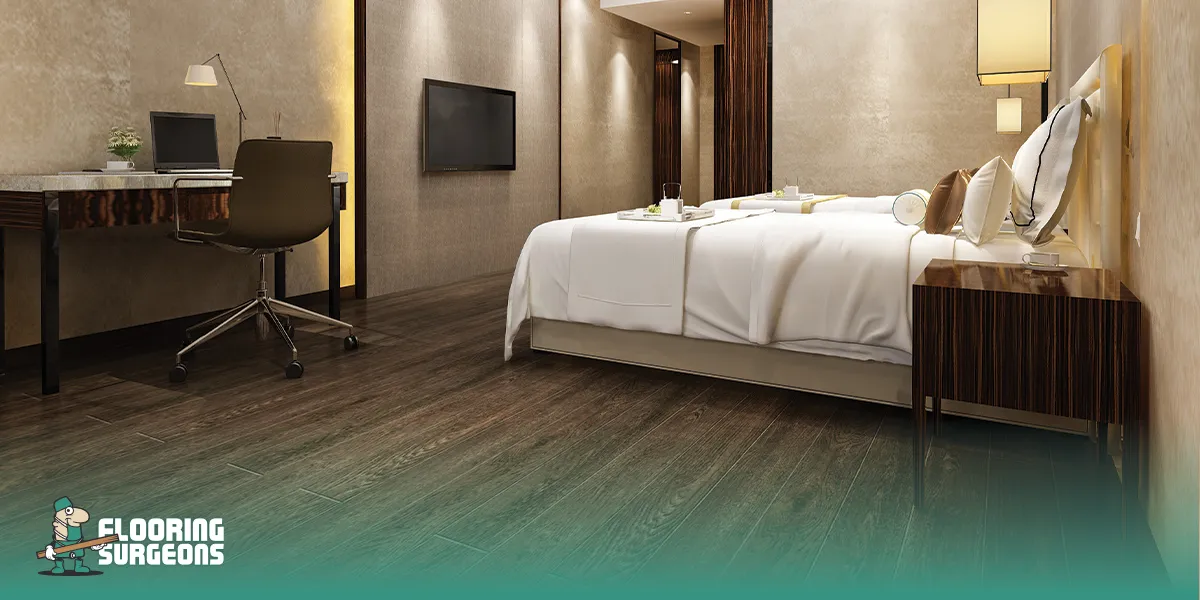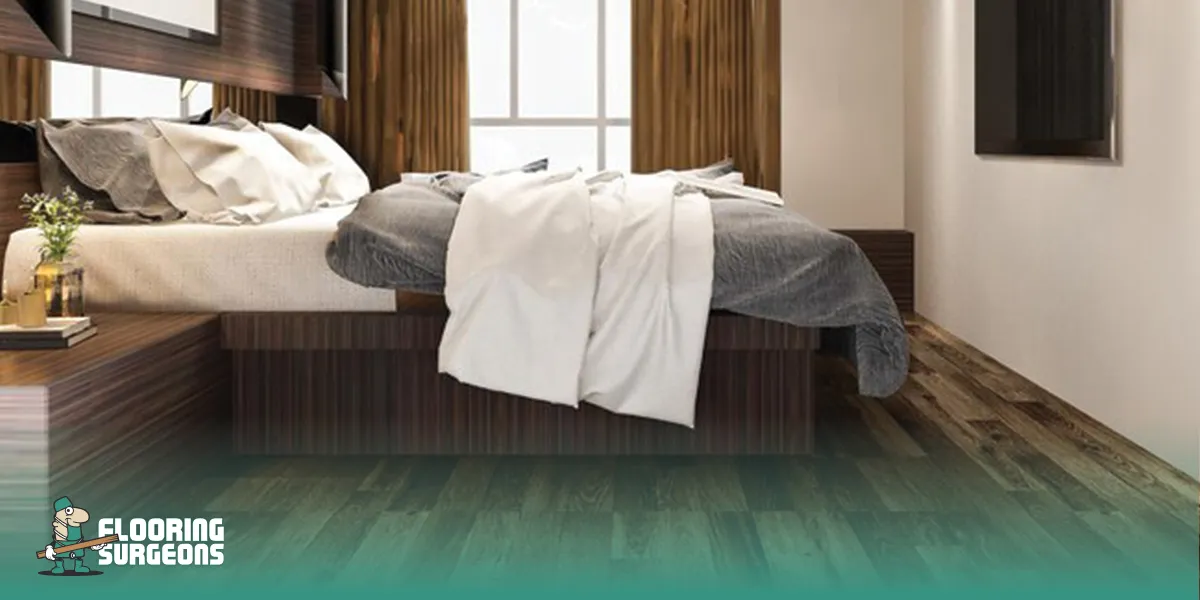Yes. Engineered flooring feels naturally warm and smooth underfoot, making it ideal for bedrooms where comfort matters most. Its wooden surface has a soft, cushioned feel that’s far more inviting than stone or tile.
Absolutely. Wood naturally retains heat better than hard surfaces like tile, and engineered wood also works perfectly with underfloor heating. This keeps your bedroom cosy in winter and comfortably balanced in summer.
Yes. The multi-layer structure absorbs sound and reduces echo, creating a calm, quiet environment that supports better sleep. Pairing it with a sound-reducing underlay makes footsteps almost silent.
Engineered wood looks cleaner and lasts longer than carpet. It doesn’t trap dust, pollen, or odours and requires minimal maintenance — perfect for allergy-sensitive households that still want a soft, natural feel.
Yes, engineered flooring is designed to be fully compatible with underfloor heating systems. Its layered build allows even heat distribution while preventing warping or surface damage.
Matte, brushed, or oiled finishes are ideal. They soften light reflections, add gentle texture, and bring a warm, spa-like feel to any bedroom interior.
Definitely, the dense core of engineered flooring handles the weight of beds, wardrobes, and dressers without denting. Felt pads under furniture feet are all you need to keep the surface pristine.
Very easy. Regular sweeping or vacuuming removes dust, and a slightly damp mop keeps the surface spotless. Because it’s sealed, it won’t absorb spills or stains like carpets or raw wood.
Yes. Bedrooms with high-quality engineered wood floors look more premium and last for decades, boosting your home’s resale appeal and perceived quality.
Of course. Many engineered wood products are made from sustainably sourced timber and low-VOC finishes. They use less solid wood overall, making them a more environmentally responsible choice for modern homes.
Engineered flooring offers a rare combination of warmth, quietness, and easy care, making it the ideal surface for people who want their bedroom to feel calm, natural, and balanced. Unlike tiles or stone, it doesn’t feel cold first thing in the morning. Unlike carpet, it doesn’t trap dust or allergens. And unlike solid wood, it doesn’t creak or shift with the seasons.
At Flooring Surgeons, we see the bedroom as the most sensory part of your home — it deserves a floor that looks elegant, feels soft underfoot, and helps you sleep better by keeping sound and temperature steady.

A bedroom has a different rhythm from the rest of your house. There’s less movement but more intimacy, less brightness but more texture. The flooring you use here must match that slower, quieter pace — soft enough to relax you, durable enough to stay beautiful for years, and smart enough to handle temperature changes through the night and across the seasons.
Let’s look at how different materials perform in a bedroom, and then we’ll see why engineered wood quietly solves all the problems others create.
Carpet used to be the default choice for bedrooms because of its warmth, but it’s no longer ideal for modern homes. It collects dust, pollen, and bacteria deep within the fibres, making cleaning a constant struggle — especially for those with allergies or pets. Over time, its colour fades unevenly, and it can trap odours that no vacuum can entirely remove.
Vinyl is strong and easy to clean, but in a bedroom, it often feels too clinical. It lacks the tactile warmth and depth that help you feel grounded and relaxed. The surface temperature stays cool, and under direct light, it can even reflect glare — not exactly the mood you want when winding down at night.
Solid wood has undeniable charm, but it’s sensitive. It expands and contracts with every change in temperature and humidity. In bedrooms with underfloor heating or poorly ventilated upper floors, this can lead to creaks, small gaps, and a surface that gradually loses its precision fit.
Stone or ceramic floors look luxurious in theory, but their cold touch and echoing acoustics make them uncomfortable in real bedrooms. They might work for entryways or bathrooms, but not for a space meant for rest and warmth.
Now, imagine a floor that captures all the good parts — the natural beauty of wood, the solid feel underfoot, the quiet atmosphere — while avoiding all the drawbacks. That’s engineered wood flooring.
Each board is built like a living system: a genuine hardwood surface bonded to multiple cross-layered cores of birch, pine, or HDF. This structure keeps the plank dimensionally stable, meaning it won’t expand, crack, or warp even if the temperature changes overnight.
The top layer — the veneer — is real wood: oak, walnut, ash, or maple. It’s sanded, finished, and sealed to highlight the grain without losing texture. That’s why when you step on engineered flooring, you feel the same warmth and softness as solid wood — but with zero worry about seasonal movement or structural stress.
And because the construction process uses thin hardwood veneers instead of full timber, it’s also a more sustainable choice: less tree consumption, less waste, and the same visual impact.
Temperature comfort is one of the biggest reasons homeowners choose engineered flooring for bedrooms. The wood surface naturally retains warmth and works perfectly with underfloor heating systems, distributing heat evenly without bending or drying out.
Colour plays a significant role too. Pale oaks, sand beiges, or soft greys help small bedrooms feel spacious and bright, while richer tones like smoked walnut or coffee oak create a cocooning sense of calm. Unlike synthetic materials, real wood subtly shifts its tone throughout the day — warm in the morning light, deeper and softer at night — creating an emotional connection that never feels artificial.
If you like to walk barefoot, engineered wood is exactly what you want — it feels alive, not flat or cold, and its micro-textured finishes add a sense of tactility that makes the room instantly inviting.
A good night’s sleep needs silence as much as softness. Engineered flooring’s layered construction absorbs vibration and naturally dampens noise, turning echoes into gentle thuds and footsteps into whispers. That means no creaking, no hollow tapping, and no disturbance when someone else walks across the room.
This makes it ideal not just for bedrooms, but also for flats, duplexes, and upstairs master suites, where reducing transmission noise is crucial. Combined with a high-quality underlay, it can reduce sound transfer by 20–30%, creating the kind of stillness that truly supports rest.
It’s the flooring you don’t notice — and that’s precisely the point.
Everyone’s version of comfort looks different — that’s why Flooring Surgeons helps customers choose engineered flooring that suits their personal needs:
Whatever your style, engineered flooring adapts — it doesn’t dominate. It quietly elevates the entire space, letting your bedroom remain exactly what it should be: a place where design and rest coexist.
Think about how a spa feels: calm, grounded, and effortlessly beautiful. That’s the atmosphere engineered wood can bring into your bedroom.
Its organic surface texture interacts gently with light — softening brightness in the morning and deepening warmth at night. The result is a surface that feels soothing to both the eye and the touch.
Unlike synthetic flooring, engineered wood holds a steady, natural temperature. When paired with subtle lighting, linen bedding, and neutral walls, it creates a sensory balance — warm underfoot, quiet in tone, and visually harmonious. The multi-layer core keeps each board perfectly aligned, so you never get that uneven step or hollow echo that breaks the calm.
In modern interior design, bedrooms are no longer just sleeping areas; they’re private sanctuaries for reading, stretching, or simply being still. Engineered flooring supports that lifestyle with its tactile calmness — real wood you can live with, not just look at.
Tip: Opt for matte or oiled finishes instead of glossy ones—they diffuse light better and add that “barefoot spa” feeling without the maintenance fuss.

Across hundreds of renovation projects, Flooring Surgeons has seen how engineered flooring transforms ordinary bedrooms into characterful, modern spaces.
In a contemporary London loft, pale oak engineered planks brought warmth and contrast to concrete walls — instantly softening the industrial edge.
In a country-style master suite, wide-plank walnut added depth and luxury, complementing textured linens and soft lighting.
And in a family guest room, neutral-toned engineered ash made the space brighter and easier to clean after weekend visits.
Designers often describe the result as “quiet luxury” — not loud or showy, but perfectly balanced. The beauty lies in the surface detail: the subtle brushing, the visible grain, the seamless joins that keep the floor visually calm.
Each of these real bedrooms shares one thing in common — the way engineered flooring connects the space emotionally. It’s not about flooring anymore; it’s about how a room feels when everything just works together.
Installing engineered flooring in a bedroom is refreshingly straightforward. The system is designed for clean, quick fitting — ideal for spaces where comfort, silence, and precision matter most. Thanks to its stable layered construction, it can be installed without complex tools or adhesives, keeping disruption in your home to a minimum.
Most bedroom engineered wood flooring uses a floating system or click-lock mechanism, allowing each board to fit securely without glue or nails. The result is a smooth, gap-free finish that feels solid underfoot but is easy to remove or replace later if needed.
For smaller bedrooms or attic rooms, floating floors are beneficial—they minimise installation time and eliminate mess, so you can walk on your new floor the same day it’s installed. For homeowners who prefer a more permanent fit, a complete glue-down installation provides added sound absorption and stability, making it ideal for master suites or upper floors.
A warm floor changes everything about how a bedroom feels. Engineered flooring is fully compatible with underfloor heating systems, unlike traditional solid wood, which may not be.
Its multi-layer structure allows heat to pass through evenly while resisting expansion or cupping. This means no cracking, no lifting, and no temperature hotspots — just gentle, consistent warmth that stays comfortable year-round.
When combined with thermostatic control, the result is a quiet, cosy bedroom floor that’s always the right temperature — soft underfoot in winter mornings and comfortably cool in summer.
The best way to choose your bedroom flooring is to see and feel it yourself. At Flooring Surgeons, you can order free samples of our engineered wood collections before making any decision.
Each sample lets you test how the tone looks in your natural light, how the surface feels to touch, and how it matches your walls or furniture. It’s an easy, risk-free way to explore your options—and discover just how elegant and relaxing your bedroom can feel with the right flooring.